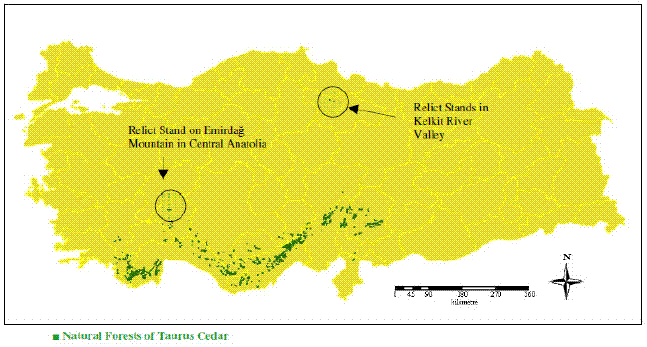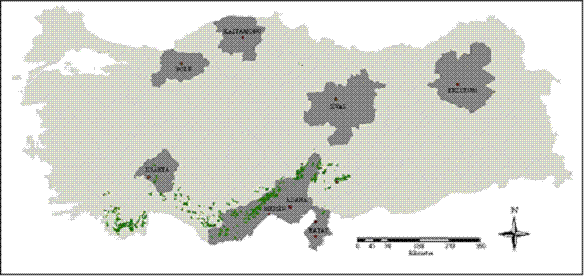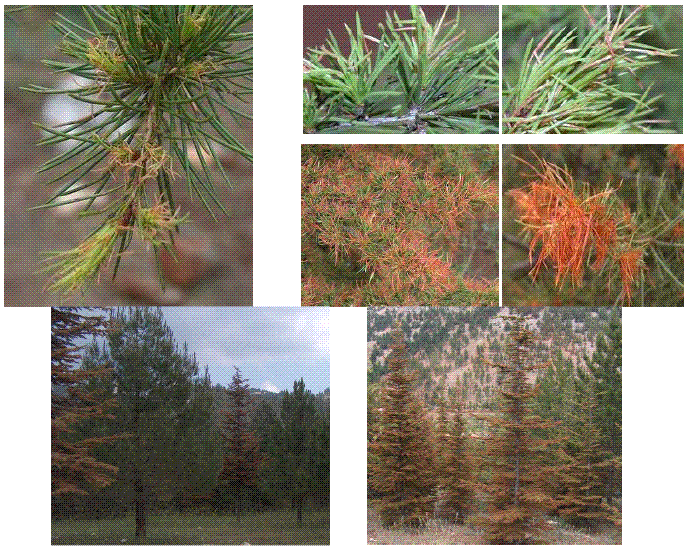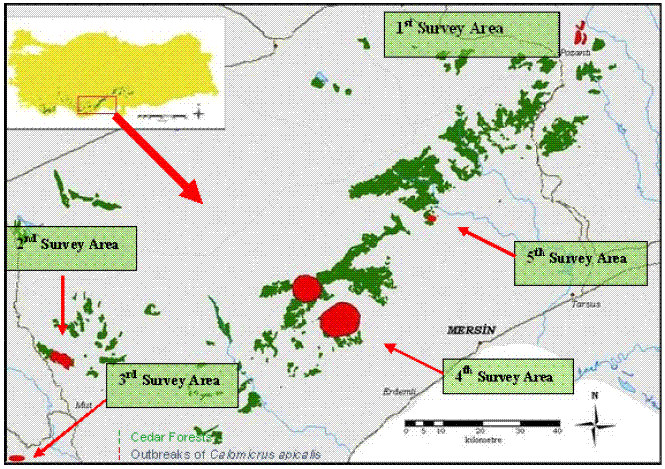Serviços Personalizados
Journal
Artigo
Indicadores
-
 Citado por SciELO
Citado por SciELO -
 Acessos
Acessos
Links relacionados
-
 Similares em
SciELO
Similares em
SciELO
Compartilhar
Silva Lusitana
versão impressa ISSN 0870-6352
Silva Lus. vol.19 n.Especial Lisboa 2011
Biology and Control of Calomicrus apicalis Demaison, 1891 (Col.: Chrysomelidae), a New Pest of Cedrus libani A. Rich. in Turkey
1 Fatih Aytar, 2 Said Dağdaş and 1 Celalettin Duran
1 Eastern Mediterranean Forest Research Institute - Dept. of Entomology, P.K. 18. 33401, Tarsus-Mersin, TURKEY
2 State Planning Organization-GD for Regional Development and Structural Adjustment, & Central Anatolia Forest Research Institute – Ankara, TURKEY
Abstract
Cedrus libani A. Rich., known as Lebanon Cedar or Taurus Cedar, is an important tree species native to the Taurus Mountains in Turkey. Worldwide, the largest forests of C. libani occur in southern Turkey and cover an area of 417.188,5 ha, although relict stands can also be found in the Emirdağ Mountains of Central Turkey and near the Akıncı and Çatalan villages of the Black Sea coast, in northern Turkey. Additionally, there are also relict forests in Syria (400 ha) and Lebanon (2,200 ha). Calomicrus apicalis Demaison, 1891 (Col.: Chrysomelidae) is an endemic species and a new pest of Taurus Cedar in Turkey. This insect was found for the first time in Hassa-Akbez forests (Hatay province) in 1891. The populations of C. apicalis have been increasing rapidly since 2000, and from an initial area of 20–30 ha this harmful leaf beetle spread rapidly and nowadays can be found on over 3000 ha of forest, not only in the Taurus Mountains but also in the new plantations/forests in Eastern and Central Anatolia. Beetle attacks have been threatening and affecting the health of young stands of C. libani, as they feed on needles of seedlings and young trees in the spring. The leaves affected by the pest undergo subsequent discoloration then dry up. In this paper we report on the most important aspects of the biology and distribution of this new pest in Turkey, and discuss possibilities of management and control against it.
Key words: Leaf beetle; Taurus Cedar (Cedrus libani); pest; Galerucinae;Eastern Mediterranean
Biologia e Controlo de Calomicrus apicalis, 1891 (Col.: Chrysomelidae, uma Nova Praga de Cedrus libani A. Rich na Turquia
Sumário
Cedrus libani A. Rich., conhecido como cedro-do-líbano ou cedro-de-taurus, é uma importante espécie florestal nativa das montanhas Taurus, na Turquia. As maiores florestas desta espécie podem encontrar-se no sul da Turquia, cobrindo uma área de 417.188,5 ha, embora florestas-relíquia também possam ser encontradas nas montanhas Emirdağ no centro da Turquia, e perto de Akıncı e Çatalan na costa do mar Negro, no norte da Turquia. Adicionalmente, também existem florestas-relíquia na Síria (400 ha) e Líbano (2,200 ha). Calomicrus apicalis Demaison, 1891 (Col.: Chrysomelidae) é um insecto endémico e uma nova praga das florestas de cedro na Turquia. Este insecto foi detectado pela primeira vez em Hassa-Akbez (província de Hatay) em 1891. As populações de C. apicalis têm aumentado rapidamente desde o ano 2000, e de um foco inicial de 20-30 ha esta praga disseminou-se rapidamente e actualmente afecta mais de 3000 ha de floresta nas montanhas Taurus e em novas plantações no Este e centro da Anatólia. Ataques deste insecto têm ameaçado e afectado a sanidade de florestas jovens de C. libani, com os adultos a alimentarem-se nas agulhas de plantas jovens na Primavera. As folhas afectadas sofrem descoloração e eventualmente secam e caem. Neste trabalho apresentamos os aspectos mais importantes da biologia e distribuição desta nova praga na Turquia, discutindo-se possibilidades de controlo e gestão das populações deste insecto.
Palavras-chave: Desfolhador; cedro-de-taurus (Cedrus libani); praga; Galerucinae; Mediterrâneo Oriental
Introduction
Cedrus libani A. Rich (Taurus Cedar) (Katran in Turkish) is one of the most important tree species of Turkey. Large forests are found in the Taurus Mountains of southern Turkey, where it covers 417.188,5 ha (ANONYMOUS, 2006) (Figure 1). Small natural populations can also be found in Lebanon (2 200 ha) and Syria (400 ha) on the anti-Taurus Mountains (AKSOY and ÖZALP, 1990; DAĞDAŞ, et al., 1997; DAĞDAŞ, 2006; KAWAR, 2001; CIANI and CASTILLO, 2005). Except near the coastal areas, it is widely used in afforestations in Turkey, being the second most abundant species after Turkish Red Pine in terms of seedling production and plantations in recent years.

Figure 1 - Natural Distribution of Cedrus libani (Taurus Cedar) in Anatolian Peninsula, Turkey
Taurus Cedar is planted both for industrial use (due to the high quality of wood) and erosion control, also being a common ornamental tree in urban forestry and landscaping. The wood is used in the industry because of its agreeable odour, resistance and multiple applications such as furniture, shipbuilding, decoration, underwater constructions, etc. (YALTIRIK, 1988; ANŞIN and KÜÇÜK, 1990; BOZKURT, et al., 1990; GÜNAY, 1990).
The main pests of Taurus Cedar are Acleris undulana Wlsghm(Lep.: Tortricidae), Dichelia cedricola (Diakonoff) (Lep.: Tortricidae), Orthotomicus tridentatus Eggers, (Col.: Scolytidae) and Calomicrus apicalis Demaison, (Col. Chrysomelidae) (ANONYMOUS,2004, 2005, 2006a, 2007a; AYTAR et al., 2008). While O. tridentatus affects the cambium layer of the trees, A. undulana, D. cedricola, and C. apicalis damage the leaves and shoots. Calomicrus apicalis is a new pest that has been causing significant damage to young cedar plantations in the last two years. The pest is native to the Anatolian peninsula and was first found in the Hatay province in 1891 (BEZDĚK, 2006). Until 2006 there were no reports of damage to cedar forests in spite of its frequent detection in the field (ASLAN et al., 2000; GÖK and DURAN, 2004; GÖK and ÇILBIROĞLU, 2005).
In this paper we report on the identification, damage, distribution and biology of this recently-emerging pest in Turkey.
Materials and methods
Studies were conducted on young Taurus Cedar plantations (5–35 years old) and also on mixed pine/cedar forests in the central Mediterranean region of Turkey, from the years 2000 to 2008. After 2003, observations focused on stands with high C. apicalis populations at the Mersin Regional Forest Directorate in Gülnar-Kayrak, Mut-Dandi, Erdemli-Hacıalanı, Mersin-Sadiye and Adana Regional Forest Directorate in Pozantı-Kamışlı. In 2006 the collected insects were sent to the taxonomy specialist Dr. Jan BEZDĚK (Mendel University of Agriculture and Forestry, Department of Zoology, Czech Republic) for identification. Reports on the locations where the population increased and on highly damaged areas were given by the Mersin Regional Forest Directorate.
Results
The taxonomic classification of C. apicalis is given below:
Order Coleoptera
Family Chrysomelidae
Subfamily GalerucinaeLatreille, 1802
Genera Calomicrus Stephens, 1831
Species Calomicrus apicalis Demaison, 1891
Synonyms Calomicrus atrocephalus (REITTER, 1895) (ASLAN, et al., 2000; GÖK and DURAN, 2004; BEZDĚK, 2006)
Calomicrus apicalis Demaison, 1891 (BEZDĚK, 2006)
Luperus (s. str.) apicalis (BEZDĚK, 2006)
Luperus apicalis Wilcox, 1973 (BEZDĚK, 2006)
Luperus (Calomicrus) apicalis Guillebeau, 1891 (BEZDĚK, 2006)
Luperus (Calomicrus) atrocephalus Reitter, 1895 (ASLAN et al., 2000; BEZDĚK, 2006)
Luperus atrocephalus Medvedev, 1970 (BEZDĚK, 2006)
Calomicrus atrocephalus Weise, 1898 (BEZDĚK, 2006)
Calomicrus peyroni (Pic, 1899) (syn. nov.) (BEZDĚK, 2007)
Identification: Adults measure about 2.5–4.1mm in length. Body and part of the legs golden blonde in colour, head and abdomen darker (Figure 2). Antennae with 11 segments and approximately 2.2mm in length.

Figure 2 - Calomicrus apicalis A. Adult male, penis dorsal, penis lateral (from BOROWIEC, 2007). B. Female. C. Adult on Cedrus libani A. Rich
Adults of C. apicalis were found in Taurus cedar forests between 1000– -1600m, from the beginning of May to late July. Insects were also collected in Pinus brutia Ten. forests up to 250m, in the beginning of April.
Distribution in Turkey: Adana (Pozantı), Mersin (Uzuncaburç-Silifke, Atdağ-Çamlıyayla), Erzurum (Urubat, Madenli), 1970), Bolu, Sivas, Kastamonu, Erzurum, İskenderun, Hatay (ASLAN et al., 2000; GÖK and DURAN, 2004) (Figure 3)

Figure 3 - Distribution of Calomicrus apicalis in Turkey
Distribution in the world: Turkey and Syria (BEZDĚK, 2006; BOROWIEC, 2007)
Host plants: Cedrus libani A. Rich., Pinus brutia Ten., Pinus nigra J. F. Arnold subsp. nigra var. caramanica (Loud.) Rehder and Pinus sylvestris L. (ASLAN et al., 2000; GÖK and DURAN, 2004; GÖK and ÇILBIROĞLU, 2005)
Damage and symptoms: Adults of C. apicalis feed on the newly formed needles and seedlings of young Cedrus libani trees. The damaged leaves become yellowish and reddish, and eventually dry and fall out (Figure 4).

Figure 4 - Damage of Calomicrus apicalis to Cedrus libani
Surveys Conducted
Surveys were conducted in five different study areas (Figure 5) and the results of the observations for each area are given below:

Figure 5 - Location of Calomicrus apicalis outbreaks in the Central Mediterranean Region
A) Survey Area I: Located near Kamışlı (elevation 800 m) in the Pozantı Forest District (Adana province), being the easternmost of the selected areas. Stands consist of mixed plantations of Taurus Cedar and Black pine with 10–15 years of age. Observations conducted during mid-June 2000 found 40–50 young cedars affected by Calomicrus apicalis adults feeding on leaves.
B) Survey Area II: Located near Dandi (elevation 900 m) in the Mut Forest District, consisting of mixed Taurus Cedar and Black pine plantations, although in 2003 C. apicalis was only found on young C. libani trees.
C) Survey Area III: Located near Gülnar-Kayrak (elevation 1100 m), situated in the westernmost part of the study area. Low abundance of C. apicalis was found in 5–10 year-old Taurus Cedar plantations in early June 2005.
D) Survey Area IV: Known as Hacıalanı-Erdemli (elevation 1400 m), with 15–30 year-old C. libani plantations. Damage by C. Apicalis on leaves of young cedar trees were observed in 600 ha in 2006 and 2007. In these stands the first extensive epidemic attacks by C. apicalis were observed, with over 1500 ha (out of 3000 ha) affected. As the life cycle, biology and natural enemies of the pest were unknown, chemical control (insecticide) was used to combat this pest for the first time.
E) Survey Area V: The second major outbreak of C. apicalis in Turkey occurred in this location in 2007, near Sadiye-Mersin (elevation 950 m). Stands consist of mixed plantations of Taurus Cedar and black pine of 5 to 10 years old. Chemical control was also used to control the pest using two insecticides.
There were high populations of C. apicalis in the first, second, and third survey areas, although as they never reached epidemic levels no control measures were employed. On the other two locations the C. apicalis populations reached epidemic levels and expanded to adjacent young plantations. In the first years (2000) the outbreak was nearly 30–40 ha, but in recent years the affected area expanded to almost 3000 ha.
Conclusions
Considering the recent outbreaks and range expansion of this new pest in Turkey, the following measures should be implemented:
· Periodic risk assessment of insects and pathogens on affected forests should be established by using GIS ( www.ogm.gov.tr ), which would also create detailed mapping;
· Research on control methods should be prioritized and supported in the problematic cedar forest locations;
· Provenance trials for resistant provenances to the pest should be evaluated for future plantations, taking advantage of the two provenance trials of Taurus Cedar already established (Aslanköy-Akpınar in Mersin Forest Regional Directorate and Feke-Mansurlu-Soğukoluk in Adana Forest Regional Directorate) (DAĞDAŞ et al., 1997; 2002);
· Risk assessment techniques should be employed for early determination of the outbreaks, as used at regional and national levels in the United States (ANONYMOUS, 2007b) and other countries of the Mediterranean basin. For these studies participation of forest health specialists from the General Directorate of Forestry, GD of Afforestation and Erosion Control, Forest Research Directorates and the forestry faculties is needed for risk mapping, monitoring, evaluation and management.
· Cooperation among the Mediterranean-basin countries on combating this and other pests should be established.
References
AKSOY, H., ÖZALP, G., 1990. Türkiye’de Sedirin (Cedrus libani A. Rich.) Orman Toplumları (Forest Communities of Cedar in Turkey). International Cedar Symposium. 22–27 October, pp. 93-102. Antalya/Turkey.
ANONYMOUS, 2004. Orman Zararlıları ile Mücadele Faaliyet Raporu. Data of General Directorate of Forestry for 2004, Ankara. [ Links ]
ANONYMOUS, 2005. Orman Zararlıları ile Mücadele Faaliyet Raporu. Data of General Directorate of Forestry for 2005, Ankara. [ Links ]
ANONYMOUS, 2006. Orman Varlığımız. Çevre ve Orman Bakanlığı, Orman Genel Müdürlüğü, 160 pp. Ankara. www.ogm.gov.tr/bulten/bulten1.htm [ Links ]
ANONYMOUS, 2006a. Orman Zararlıları ile Mücadele Faaliyet Raporu. Data of General Directorate of Forestry for 2006, Ankara. [ Links ]
ANONYMOUS, 2007a. Orman Zararlıları ile Mücadele Faaliyet Raporu. Data of General Directorate of Forestry for 2007, Ankara. [ Links ]
ANONYMOUS, 2007b. Mapping Risk from Forest Insects and Diseases. USDA Forest Service-Forest Health Protection, 98 pp. [ Links ]
ANŞIN, R., KÜÇÜK, M., 1990. Niksar ve Erbaa Yöreleri Doğal Sedir Meşcerelerinde Floristik Araştırmalar. International Cedar Symposium. 22–27 October, pp.1-11. Antalya/Turkiye. [ Links ]
ASLAN, İ., WARCHALOWSKI, A., ÖZBEK, H., 2000. A Preliminary Review of the Subfamily Galerucinae (Coleoptera, Chrysomelidae) in Turkey. J. Ent. Res. Soc. 2(2): 27–42. [ Links ]
AYTAR, F., SARIKAYA, O., AVCI, M., 2008. Toros Sediri Ormanlarımızda Önemli Bir Zararlı: Sedir Kabuk Böceği (Orthotomicus tridentatus). "An important pest on Taurus Cedar Forest; Cedar Bark Beetle (Orthotomicus tridentatus)". Journal of Forest Engineering 45: 1,2,3: 19-23. [ Links ]
BEZDĚK, J., 2006. Calomicrus atrocephalus (Reitter, 1895), a new synonym of Calomicrus apicalis Demaison, 1891 (Coleoptera: Chrysomelidae: Galerucinae). Genus 17(3): 359-362. [ Links ]
BEZDĚK, J., 2007. Taxonomical changes in Palaearctic Luperini (Coleoptera: Chrysomelidae: Galerucinae). Annales Zoologici 57(2): 257-266. [ Links ]
BOROWIEC L., 2007. www.biol.uni.wroc.pl/cassidae/European_20Chrysomelidae/calomicrus_20apicalis.htm. [visited date: 15/08/2008] [ Links ].
BOZKURT, Y., GÖKER, Y., ERDIN, N., 1990. Anatomies and Technological Properties of the Cedar Trees (Toros Sediri (Cederus libani A. Rich.)’nin Anatomik ve Teknolojik Özellikleri) International Cedar Symposium. 22–27 October, pp. 754-764. Antalya/Turkiye.
CIANI A.C. CASTILLO, P., 2005. The Desertification Process in the Last Natural Forest of the Southern Mediterranean Region. www.psy.unipd.it/~eto/testi/articoli/cretepau.html (25 December 2005). [ Links ]
DAĞDAŞ, S., GENÇ, A., DOĞAN, B., CENGIZ, Y., KESKIN, S., ÖRTEL, E., UĞURLU, S., 1997. Türkiye'de Sedir (Cedrus libani A. Rich.) Orijin Denemelerinin İlk Sonuçları, "The first results of Cedar (Cedrus libani A. Rich.) provenance tests in Turkiye". İç Anadolu Ormancılık Araştırma Enstitüsü Yayınları, Teknik Bülten Serisi, Nu.: 271, 128 pp. [ Links ]
DAĞDAŞ, S., DOĞAN, B., CENGIZ, Y., KESKIN, S., IŞIK, F., KARATAY, H., 2002. Türkiye'de Toros Sediri (Cedrus libani A. Rich.) Orijin Denemeleri: On Yıllık Ara Sonuçlar, «Ten year old results of Taurus Cedar (Cedrus libani A. Rich.) Provenance tests in Turkiye», İç Anadolu Ormancılık Araştırma Enstitüsü Yayınları, Teknik Bülten Serisi (Not published). [ Links ]
DAĞDAŞ, S., 2006. Beyşehir ve Yakın Çevresinde Tesis Edilen Ormancılık Araştırma Denemeleri / Ulaşılan Bulguların İrdelenmesi ve Bazı Öneriler. "Evaluations and recommendations of forestry research trials in the vicinity of Beyşehir Forest District located in Transition Zone of Mediterranean Region to Central Anatolia", I. Uluslararası Beyşehir ve Yöresi Sempozyumu (11–13 MAYIS 2006)-Beyşehir-KONYA, Bildiri Özetleri Kitapçığı, pp. 83, 97; Bildiriler Kitabı, pp. 641-659, 785 pp.
GÖK, A., DURAN, E., 2004: A Survey of the Subfamily Galerucinae (Coleoptera: Chrysomelidae) of Isparta Province (Turkey), with Two New Records. J. Ent. Res. Soc. 6(2): 15-24. [ Links ]
GÖK, A., ÇILBIROĞLU, E.G., 2005. Studies on the abundance, biology and harmfulness of leaf beetles (Coleoptera: Chrysomelidae) in natural bush vegetation in Isparta, Turkey. J. Pest Sci. 78: 13-15. [ Links ]
GÜNAY, T., 1990. Afyon-Emirdağ Yukarı Çaykışla Vadisi'nde Stebe Geçiş Kuşağında Yeni Tespit Edilen Bir Sedir (Cedrus libani A.Rich.) Kalıntı Meşceresi ve Ekolojik Özellikleri. International Cedar Symposium. 22–27 October. pp. 53-63. Antalya/Turkiye. [ Links ]
KAWAR, N.S., 2001. Insect Pests of Cedar Forests in Lebanon. Workshop on "Assessment of the scale of Insect Infestation in Cedar Forests in Lebanon and the Mediterranean Region". GEF Medium Size Project-Integrated Management of Cedar Forests in Lebanon in Cooperation with Mediterranean Countries. [ Links ]
MIRZOEVA, N., 2001. A study of the ecofaunal complexes of the leaf–eating beetles (Coleoptera, Chrysomelidae) in Azerbaijan. Turk. J. Zool. 25: 41-52. [ Links ]
YALTIRIK F., 1988. Dendroloji Ders Kitabı. I. Cilt Gymnospermea (Açık Tohumlular). İ.Ü. Orman Fak. Yayın No: 3443/386. [ Links ]
Acknowledgements
Our thanks to Dr. Jan BEZDĚK (Mendel University of Agriculture and Forestry, Department of Zoology, in Czech Republic) for the identification studies.













